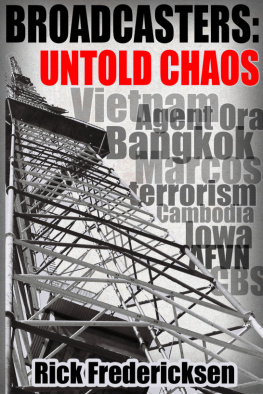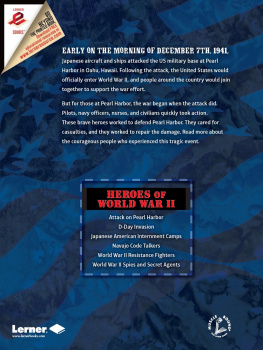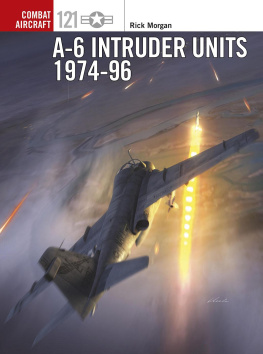Broadcasters: Untold Chaos
By Rick Fredericksen
Copyright 2017 Rick Fredericksen
Smashwords Edition
Smashwords Edition, License Notes
This ebook is licensed for your personal enjoymentonly. This ebook may not be re-sold or given away to other people.If you would like to share this book with another person, pleasepurchase an additional copy for each recipient. If youre readingthis book and did not purchase it, or it was not purchased for youruse only, then please return to Smashwords.com and purchase yourown copy. Thank you for respecting the hard work of theseauthors.
Cover design and formatting by Caligraphics
Table of Contents
Preface
I initially scoffed when friends suggestedwriting a book, until realizing that I was sitting on a gold mineof documentation saved over a broadcasting career of nearly 50years. It was in my blood to hoard these things: several thousandradio and TV scripts, notebooks, videotapes, photos, audiorecordings and war letters home from Vietnam. It seemed importantthat some of this should become part of the written record,especially several big news events and inside stories that I wasinvolved with but which havent been properly told. This is mycompilation of accounts that deserve more attention. It is also myway of honoring broadcast journalism and the indispensablecolleagues who helped me along the way, people like Paul Rhoades,Russ Van Dyke, Bob Sevey, Derek Williams and Rick Lewis. Itcontinues to be a gratifying career.
Special acknowledgment goes to Michele McNabbfor her keen vision and essential guidance in the role ofmanuscript editor.
Cover photo: The 300-foot broadcast tower usedby the American Forces Vietnam Network was the tallest structure inSaigon and stood for more than 46 years. An armed lookout had acommanding view from the elevated guard shack about 75 feet aboveground.
Telex Message: CBS News,Saigon to CBS News Foreign Desk, New York.
Weve brought on another freelance cameraman tocover the I-Corps region up north. Hes from Hue, so that is hishome base. His name is Vinh Ve. Payroll information to follow.
The mysterious, flickering lights first began toappear as darkness closed in on the city of Hue, South Vietnam in1967. They could be seen from low-flying Huey helicopters, fromplaces as tall as the seven-tiered Thien Mu Pagoda on the outskirtsof town, and perhaps through field binoculars from the foothills ofthe nearby Truong Son Mountains. The intermittent lights pulsated;going from bright white to totally black, but unlike flipping alight switch. From a distance, the curious beams were stationary,and yet there was movement at the same time. At first glance,superstitious Vietnamese didnt know what to think. Enlightenment,however, came faster than you could change the channel. Televisionhad arrived in the far reaches of South Vietnam. It was one of thegood things to happen in a country at war.
The visual phenomenon blossomed as the calendarturned into 1968. On the evening of January 30th, during the TetLunar New Year, TV programming included the popular World War IItelevision series Combat. Channel-11 in Hue was a service ofthe American Forces Vietnam Network, operated by a small group ofbroadcast specialists. Prior to the arrival of the United Statesmilitary, television had never been seen in this part of the world.From the earliest transmissions, Vietnamese were enamored with theinvention, and U.S. troops welcomed the stations entertainment andnews programming as a reminder of home.
As Sergeant Chip Saunders (played by actor VicMorrow) was taking his squad into combat against German soldiers onthe black-and-white screen, there was little alarm when Vietnameseregional forces opened fire at a group of enemy soldiers probingthe outskirts of Hue.
Soon after the shooting started, a loneVietnamese man dashed past the TV station on his motorcycle andcrossed a bridge over the Perfume River near the Citadel complex,just to make sure the ancient imperial capital was secure. It wasVinh Ve, then 31 years old, taking shortcuts in the direction ofenemy contact. With him was his CBS-issued 16mm Bell and Howellcamera. He was a photojournalist. Vietnam was his beat. The firingsubsided, and Vinh Ve returned home to enjoy the New Year with hisfamily. But Hue was on edge.
Earlier that day, President Nguyen Van Thieu hadcancelled furloughs for the South Vietnamese armed forces after thecommunist North Vietnamese and Viet Cong had violated a holidayceasefire. They hit unsuspecting targets in the northern I-Corpsarea, the operational zone where Hue was located. Still, the oldroyal city had reason to feel immune from major attack. Locatedmidway between the warring capitals of Saigon and Hanoi, in somesense Hue was nonaligned. It was a major cultural and religioushub, and home of the prestigious Hue University.
Politically speaking, the citys largeconcentration of Buddhists and Catholics disliked war in generaland both sides that were waging it. It was about as neutral as anycity could be in Vietnam. But the population of 140,000 could sensetrouble; shops had closed early that day. Even the house ofprostitution had shut down.
An alert had gone out to all AFVN affiliates,not just in Hue, warning that our facilities may be a target forenemy attack, and should be prepared to go off the air. But themen assigned to operate AFVN in Hue that night finished theevenings broadcast schedule with Combat, followed by TheFugitive, according to a published program schedule.
It was the United States military that hadintroduced television to southern Vietnam two years earlier, withthe deployment of Navy C-121 Super Constellationaircraftessentially, flying television stations complete withantenna, transmitter, film projectors, videotape machines, and evena small studio for live newscasts. Known as Blue Eagles, they flewin circles about 11,000 feet above Saigon, and later, the MekongDelta. There was a secondary Vietnamese channel, but for locals andexpatriate viewers alike, English-language blockbusters likeBonanza were the prime-time fan favorites. For several hoursevery evening, the Constellations went on-the-air from the air,broadcasting signals that could be picked up by rabbit earantennas up to 50 miles away, easily covering the capital city.
To receive the pictures and audio the U.S.government distributed TV sets for less than the cost of one loadof bombs, according to Michigan Congressman Charles Chamberlain.He considered television a potent weapon, one that would helpdefeat the Viet Cong. By the end of 1966, TV Guide reportedthat 46,000 television sets had been sold at Post Exchanges inSaigon. Throngs of Vietnamese flocked around the small screens intown squares, in store windows, and at coffee shops. Americanswatched in rec rooms and military barracks. Later, servicemenbought small portables for private viewing in their hooches.
The historic first broadcast attractedinquisitive Vietnamese to the center of Saigon, where pioneerbroadcaster Air Force Master Sergeant Shelly Blunt reported back toAFVN from a small park: They placed two receivers on a platform soeveryone could see and hear. It sort of reminded me of sitting inthe last row of the Hollywood Bowl. Then he described a bar scenenear the Brink Hotel (also known as The Brinks): We noticed alarge crowd of people in the street, seemingly hypnotized at whatwas going on inside. In that moment, a TV set had come betweenlonely GIs and pretty bargirls.
A couple months after the Blue Eagles signed on,all three aircraft were damaged on the tarmac when the VC shelledTon Son Nhut Air Base. Thats when AFVN network commanders went tomore secure and more reliable ground stations. The broadcastersquickly built a true TV network of affiliate stations extendingthroughout the country. Hue was Detachment 5. On the day of itsofficial opening in 1967, the Viet Cong responded with a mortarattack. For the Vietnamese in the ancient capital, this was thefirst television theyd ever seen. When the stations original 250printed TV schedules ran out, viewers called in, asking formore.









